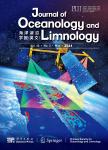Clay mineral compositions in the surface sediment of the Chanthaburi coast(northeastern Gulf of Thailand)and their implications on sediment provenance
作者机构:Third Institute of OceanographyMinistry of Natural ResourcesXiamen 361005China Department of Mineral ResourcesMinistry of Natural Resources and EnvironmentRatchathewiBangkok 10400Thailand Fujian Provincial Key Laboratory of Marine Physical and Geological ProcessesXiamen 361005China
出 版 物:《Journal of Oceanology and Limnology》 (海洋湖沼学报(英文))
年 卷 期:2023年第41卷第5期
页 面:1742-1752页
核心收录:
学科分类:070704[理学-海洋地质] 0709[理学-地质学] 07[理学] 0707[理学-海洋科学]
基 金:Supported by the National Key Research and Development Program of China (No.2019YFE0124700) the Scientific Research Foundation of the Third Institute of Oceanography MNR (No.2019026) the Marine Protected Areas Network in China-ASEAN Countries
主 题:clay mineral surface sediment provenance coast of Thailand
摘 要:Clay mineral composition represents an important tracer of sediment source area,migration processes,and paleoclimatic *** mineral analysis was performed on 15 surface sediment samples collected from the coast of Chanthaburi,*** show that the composition of clay minerals in the study area differs substantially from that in surrounding regions of the Gulf of *** clay minerals of the Chanthaburi coast are dominated by kaolinite(~56%),followed by smectite(~21%),illite(~14%),and low concentrations of chlorite(~8%).The average illite chemistry index and crystallinity are 0.93 and 0.32,*** analysis of the clay mineral composition of surface sediments in several typical areas around the Gulf of Thailand indicated that the clays of the Chanthaburi coast are mainly derived from parent rock weathering in the small watersheds of the Chanthaburi and Welu rivers and the surrounding *** input from the northern coast of the Gulf of Thailand(excluding the Mekong River)was previously considered negligible;however,the present results indicate that such input has impact on the eastern Gulf of *** warm humid climatic conditions in Southeast Asia are the primary factors that affect the strong chemical weathering in the study area,followed by the nature of the parent rock.



